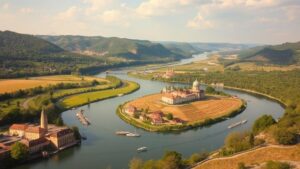Exploring the hidden river valleys of Myanmar for ancient Buddhist kingdoms.
Exploring the Hidden River Valleys of Myanmar for Ancient Buddhist Kingdoms
Myanmar, known for its breathtaking landscapes and rich cultural heritage, is home to several hidden river valleys that have played a significant role in the countrys ancient Buddhist kingdoms. These valleys not only offer a window into the past but also serve as testament to the enduring influence of Buddhism in Myanmars history. This article explores the significance of these valleys, focusing on key regions, historical context, and the treasures that lie within them.
Historical Context of Buddhism in Myanmar
Buddhism was introduced to Myanmar during the 3rd century BCE, primarily through the efforts of missionaries sent by Emperor Ashoka of India. religion flourished and led to the establishment of several kingdoms that contributed to the rich tapestry of Myanmars culture. Among these, the Bagan Kingdom (9th to 13th century) stands out as a pivotal center for the diffusion of Buddhism throughout the region.
The Bagan archaeological zone is famous for its thousands of ancient temples and stupas, which reflect the architectural prowess of its time. But, the exploration of hidden river valleys like the Irrawaddy, Chindwin, and Sittaung Rivers reveals additional layers of historical significance and cultural heritage.
Key River Valleys and Their Significance
In Myanmar, three key river valleys play crucial roles in the context of ancient Buddhist kingdoms:
- Irrawaddy River Valley: The lifeblood of Myanmar, the Irrawaddy River Valley served as the cradle of the Bagan Kingdom. Its fertile plains supported agriculture, while the river itself facilitated trade and pilgrimage.
- Chindwin River Valley: Larger than the Irrawaddy in area but less navigable, the Chindwin Valley acted as a corridor for cultural exchange between Myanmar and surrounding regions. It was instrumental in the spread of Theravada Buddhism.
- Sittaung River Valley: This region is lesser-known, but its historical temples offer insight into the religious practices that characterized the ancient city-states along this river.
The Architectural Marvels
Exploring these valleys reveals not only natural beauty but also stunning remnants of ancient civilizations. Key sites include:
- Bagan Temples: Featuring over 2,200 temples, stupas, and monasteries, the Bagan archaeological site is a UNESCO World Heritage site. Major structures like Ananda Temple and Shwezigon Pagoda highlight the intricate craftsmanship and religious devotion of the time.
- Thatbyinnyu Phaya: The tallest temple in Bagan, constructed in the 12th century, offers a panoramic view of the vast temple landscape and reflects the architectural innovations of the era.
- Mon State Temples: The temples of Mon State, including the Shwemawdaw Pagoda in Bago, showcase the blend of local and Indian architectural styles that emerged in this culturally rich region.
Significance of Preservation and Tourism
In recent years, the importance of preserving these ancient sites has gained attention. UNESCO has recognized the need to safeguard these historical treasures not only for their cultural significance but also for future generations. As interest in Myanmars history grows, sustainable tourism initiatives developed to protect these areas while promoting economic benefits for local communities.
According to the Myanmar Ministry of Hotels and Tourism, the number of tourists visiting Bagan alone increased from around 200,000 in 2014 to over 800,000 in 2019. This surge has highlighted the need for a balance between visitor engagement and conservation efforts.
Conclusion and Actionable Takeaways
Exploring the hidden river valleys of Myanmar provides a unique opportunity to delve into the countrys rich historical tapestry and the enduring legacy of its ancient Buddhist kingdoms. Whether you are an avid historian or a curious traveler, visiting these sites offers insight into the architectural grandeur and spiritual history that shaped Myanmar.
For those planning a visit, here are some actionable takeaways:
- Prioritize responsible tourism by respecting local customs and engaging with community-led initiatives.
- Plan to visit during the cooler months between October and March for the best experience.
- Consider guided tours that emphasize both the cultural and environmental significance of the sites.
By exploring Myanmars hidden river valleys, visitors can gain a deeper understanding of the countrys heritage and the profound impact of Buddhism that continues to resonate today.



